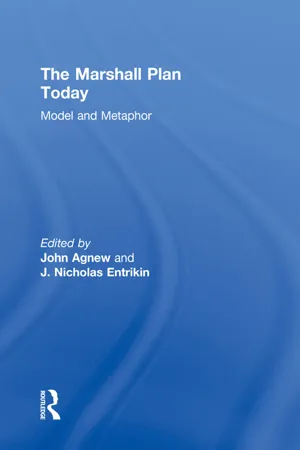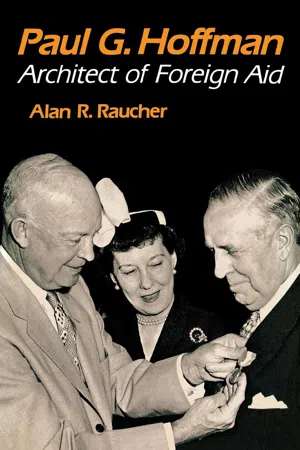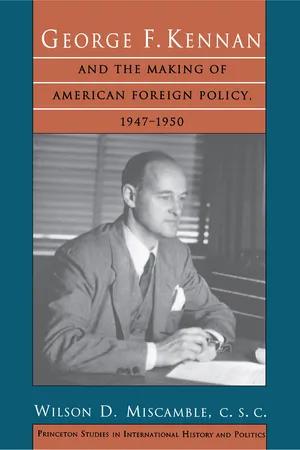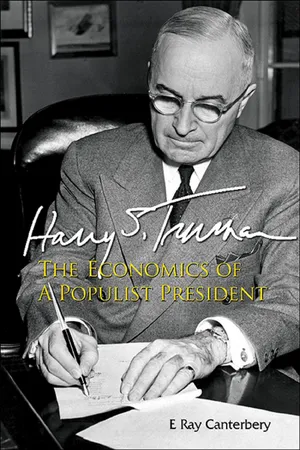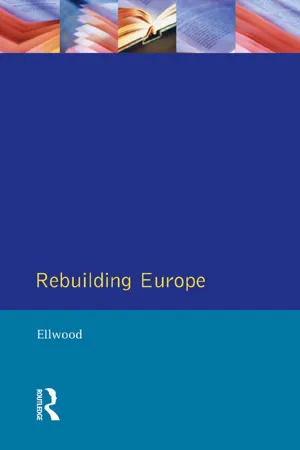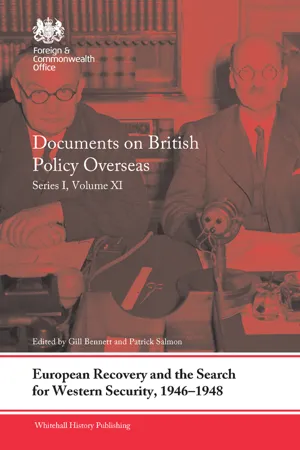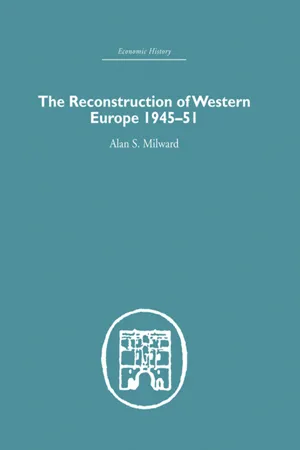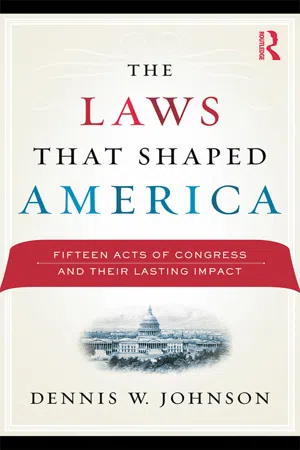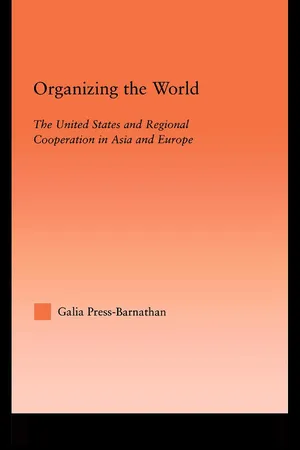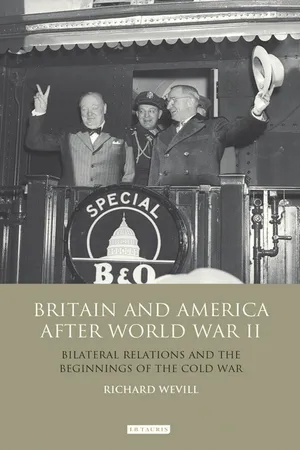History
Marshall Plan
The Marshall Plan was a U.S. initiative to aid Western Europe's economic recovery after World War II. Proposed by Secretary of State George Marshall in 1947, it provided financial assistance to help rebuild war-torn countries, stabilize their economies, and prevent the spread of communism. The plan was instrumental in fostering post-war reconstruction and fostering economic cooperation among European nations.
Written by Perlego with AI-assistance
Related key terms
12 Key excerpts on "Marshall Plan"
- eBook - ePub
The Marshall Plan Today
Model and Metaphor
- John Agnew, J. Nicholas Entrikin(Authors)
- 2004(Publication Date)
- Routledge(Publisher)
Introduction: The Marshall Plan as Model and Metaphor JOHN AGNEW AND J. NICHOLAS ENTRIKINIn a 1947 address at the Harvard University Commencement, Secretary of State George C. Marshall outlined the idea, later enshrined in the Truman Administration’s European Recovery Program, of reconstructing a devastated Europe only just emerging from World War II through the infusion of US aid on a massive scale. The Marshall Plan would eventually cost between 12 and 13 billion dollars before being subsumed by US defense spending on NATO and support for a variety of bilateral aid programs in the early 1950s. The Marshall Plan was indeed by many measures a successful international aid program, which like most such programs had more than purely philanthropic aims. Among other things, a devastated Europe was an invitation to Soviet political meddling, an opportunity for rebuilding export markets for US businesses, and a chance to experiment with creating an open world economy that would not experience repetition of the economic and political disasters of the previous twenty years.Evocative speeches at timely moments played a major role in defining and reorienting ‘Europe’ after World War II. One was Winston Churchill’s ‘iron curtain’ speech at Westminster College in Missouri in 1946. Another was George Marshall’s speech at Harvard in 1947 offering American aid and advice in rebuilding a shattered continent. A third was Robert Schuman’s speech in Paris in 1950 proposing common European control over coal and steel resources. These speeches, perhaps because they were relatively short and eloquent, captured the popular imagination of the time. They shifted thinking by creating a new conventional wisdom. With hindsight they seem like founding moments of what has happened since. The fact that two were given in the United States points to both American centrality to Europe’s future and the interweaving of destinies that was already under way. - eBook - ePub
Paul G. Hoffman
Architect of Foreign Aid
- Alan R. Raucher(Author)
- 2021(Publication Date)
- The University Press of Kentucky(Publisher)
5 TheMarshall Plan,1948-50Scholars have usually portrayed the Marshall Plan as a policy of enlightened national self-interest. Within the framework of the containment of Communism, the United States pursued peace and prosperity by unprecedented generosity toward potential economic competitors. During a period of domestic shortages and inflation, it gave the countries of Western Europe billions of dollars so that they could reconstruct their economies and reestablish normal trading patterns.Recently, some scholars have charged that the policies of the Economic Cooperation Administration differed significantly from its own rhetoric and the conventional view. According to one leading revisionist work, the ECA actually pursued a hidden agenda of shoring up American capitalism against a postwar depression. It defined successful economic recovery not by improvements in the living standard of the European masses but by the control of inflation and the narrowing of the dollar gap so that Americans could find markets for the surpluses they could not absorb domestically.1Much can be learned by looking beneath the surface of events and of the rhetoric churned out by the government’s publicity apparatus. However, the revisionist exposé compares the ECA with a standard to which the American policy-makers did not aspire. In a sense, revisionists have created a straw man of altruism and have then proved that reality fell short.For two and a half years, ending 30 September 1950, Paul Hoffman occupied a key position and made major contributions within the complex process of government policy-making. He liked to say that no man did another a greater favor than President Truman did for him by drafting him to head the Marshall Plan. “It opened my eyes to many things of which I was totally unaware,” he told one interviewer, “and it was the beginning of my real education.”2 - Wilson D. Miscamble, C.S.C.(Authors)
- 2021(Publication Date)
- Princeton University Press(Publisher)
CHAPTER TWO Launching the Marshall PlanA CRISIS SITUATION ?Kennan's first major entry as director of the Policy Planning Staff into the arena of foreign policy formulation saw him contribute in an important manner to the development of what became known as the Marshall Plan. This Plan, known officially as the European Recovery Program (ERP), has long held an exalted place on the list of postwar American foreign policy achievements. The dramatic (and flattering) picture of a wholehearted and generous American effort reviving a dispirited and prostrate Europe was the staple of the early and somewhat hagiographic accounts of the Marshall Plan and lives on as evident in the celebratory comments of public figures at the time of its fortieth anniversary in 1987.1 Whatever its impact on Europe, unquestionably the Marshall Plan marked a turning point in American diplomacy. It injected the United States into the midst of European affairs and marked a level of peacetime involvement there notably greater than in any preceding period. But recent scholarship has raised questions about the necessity of this American involvement, its origins, and its real purposes.2 Illuminating Kennan's key participation in the making of the Marshall Plan affords the opportunity to address these questions and allows a richer appreciation for how the eventual policy emerged.Alan S. Milward, an economic historian at the London School of Economics, has sought to slaughter a sacred cow of conventional interpretations of the Marshall Plan by disputing the very reality of the situation that supposedly called it forth. After amassing assorted statistical evidence he argued that Europe was not on the verge of economic collapse in the spring and summer of 1947. For him "the alleged economic crisis of the summer of 1947 in Western Europe did not exist, except as a shortage of foreign exchange caused by the vigor of the European investment and production boom."3 His argument, while noteworthy for its originality, goes completely against the grain of what everyone thought at the time.4 Perhaps Theodore White, a reporter in Paris in 1947 and 1948, engaged in retrospective hyperbole in describing Europe as a bankrupt civilization—whose condition was "that of a beached whale that has somehow been stranded high beyond the normal tides and which, if not rescued, will die, stink and pollute everything around it."5 But such views, even if more soberly expressed, were widely shared on both sides of the Atlantic. The influential Walter Lippmann publicly called attention to Europe's plight in March and April but officials within Truman's administration hardly needed to be briefed by him.6 Secretary Marshall's sincerely held conclusions about Europe's dire prospects and the resultant opportunities they presented the Soviet Union were derived from his discussions in Moscow with Ernest Bevin and Georges Bidault and from reports from American representatives in Europe.7- eBook - ePub
Harry S Truman: The Economics Of A Populist President
The Economics of a Populist President
- E Ray Canterbery(Author)
- 2014(Publication Date)
- WSPC(Publisher)
8 The Marshall PlanM uch was going on during the Campaign of 1948, including the laying of the groundwork for what would be called “The Marshall Plan.” Next, we focus on the forces that led to the Plan as well as re-visiting a famous speech. As already noted, Secretary of State George C. Marshall (1880–1959) was the key player, though there were others. Still, a good place to begin is with Marshall’s speech at Harvard in which he said, “Our policy is directed not against any country or doctrine, but against hunger, poverty, desperation and chaos. Its purpose should be the revival of a worldwide working economy promoting the survival of free institutions.” The Soviets and their Eastern European satellites were not to be to be excluded from the program but rather, were invited to participate. While the Communist bloc countries could opt out of the plan, the burden of dividing the continent would fall exclusively on them. In short, it was going to be virtually a global plan, with ripple effects throughout the world community.The goal was European self-sufficiency. The US had already provided $6 billion in postwar aid to Europe. The Marshall Plan was scheduled to cost $16.5 billion over four years, a huge amount of aid in 1947 dollars. Among the promises greatly expanded US-European trade, with a recovered Europe prosperous enough to finance purchases of American goods. The positive effect on the trade balance with its multiplier consequences was irresistible to Congress and to the country. It was a plan that would guard an unstable Western Europe from Communist subversion while also promoting the prosperity of both Europe and the United States.The speech was delivered at 2:00pm in Harvard Yard at a luncheon given for alumni, parents of alumni and select guests. No one at the time had anticipated its import. Marshall had told Harvard President James Conant that he would simply make a few remarks — and perhaps “a little more.” No one had seen the final draft of the speech, not even President Truman. It nonetheless was an address that would transform Europe, dramatically change the international political landscape, and launch America as a modem superpower with global reach. Of course, it was not simply the speech, but everything that had taken place before and after it that would be transforming. The “before” picture included the influence of Hoover’s reports. - eBook - ePub
Rebuilding Europe
Western Europe, America and Postwar Reconstruction
- David W. Ellwood(Author)
- 2014(Publication Date)
- Routledge(Publisher)
CHAPTER FIVE The Road to the Marshall PlanTHE IMMEDIATE BACKGROUND
Everyone, it turned out, had a plan. The Twentieth Century Fund had a plan, Republican Presidential aspirant Harold Stassen had a plan, former President Hoover had one, as did the leading Republican Senator Arthur H. Vandenberg, and a prominent Democrat, Senator Pepper. In April and May Walter Lippman in the Washington Post demanded abandonment of the piecemeal aid policies of the past in favour of ‘a comprehensive recovery plan agreed to by the Europeans themselves and used to support the “unification of Europe”.’1The State Department hinted it had done some planning in a speech by the Under Secretary of State, Acheson, in Mississippi in early May. This listed the grim developments in the world since the war and suggested that existing aid programmes would cover only half the gap between America's imports from abroad and her exports to the rest of the world in the coming years. United States exports had quadrupled since 1939, said Acheson, and needed to be much higher if the means could be found to pay for them in the countries of Europe and Asia most threatened by disaster. In these areas of the globe ‘emergency assistance’ was required urgently, needed in building stability, promoting freedom and democracy, ‘fostering liberal trading policies, and … strengthening the authority of the United Nations’. In his concluding remarks, Acheson, one of the key ‘wise men’ of Washington's foreign policy élite in these years, re-emphasised the fundamental American faith in the economic bases of freedom and democracy: - eBook - ePub
European Recovery and the Search for Western Security, 1946-1948
Documents on British Policy Overseas, Series I, Volume XI
- Gill Bennett, Patrick Salmon, Gill Bennett, Patrick Salmon(Authors)
- 2016(Publication Date)
- Routledge(Publisher)
CHAPTER IIIThe Marshall Plan: Phase I 5 June–22 September 1947‘At the beginning of June 1947, the shadow of an impending dollar shortage hung heavily over the world. Europe, in particular, was facing an acute strain on its foreign exchange reserves; an intensification of its food crisis was looming; and it was generally recognised in the United States that the assistance voted under the post-UNRRA programme and for Greece and Turkey would but scratch the surface of Europe’s problem. Western Europe was looking to America for a lead, and it was known that earnest thought was being given in Washington to some new move which would meet the exigencies of America’s political situation and at the same time offer fresh hope to Europe. But there were only the vaguest rumblings of what that move would be’ (UE 5665/168/53).So ran the opening paragraph of an outline report covering the early FO documentation on the Marshall Plan, or Economic Recovery Programme (ERP). Earlier documents in this volume have shown how the economic problems faced by the British government had become acute during the first half of 1947, although ministerial and official opinion differed as to their urgency and on the way to deal with them. The difficulties faced by European governments, compounded in some cases by political instability, had also become steadily more pressing and intractable since the beginning of the year, exacerbating the polarisation of Europe into eastern and western spheres of influence. This process had been regarded with increasing alarm by the United States Government, and a growing awareness of the need for American engagement if there were to be any hope of stopping or reversing the trend. The only hope for Western Europe seemed to lie with the richest and most powerful nation in the world. But how should American help be sought or given, and on what conditions? - eBook - ePub
- Alan S. Milward(Author)
- 2013(Publication Date)
- Routledge(Publisher)
III The European Recovery ProgrammeDOI: 10.4324/9781315019499-3The aspect of the economic reconstruction of Europe to which most energy and attention has been given and the one which still seems to awaken the most interest is that of the impact of the ERP on European economic and political life. To what extent is modern Western Europe the creation of the Marshall Plan? Could it have been otherwise? These are questions repeatedly mulled over in conferences and newspapers. At the height of the Cold War American scholars sought to demonstrate that the Marshall Plan was the cause of Western Europe’s remarkable economic performance and that it had ‘saved’ western Europe for democracy.1 International economists in the United States, whose subject the Marshall Plan had made important to American government policies, wrote more guardedly in much the same vein.21 The most typical of the genre is H.B. Price, The Marshall Plan and Its Meaning (Ithaca, 1955).2 H.S. Ellis, The Economics of Freedom (New York, 1950) could serve as an example.When in reaction a ‘revisionist’ school of historians appeared in the United States, attributing the Cold War as much to American policies as to those of the Soviet Union, the Marshall Plan came to be seen in an opposite light, as an act of imperialistic foreign policy by the United States.3 In extending its great power interests to the river Elbe, and even beyond, the United States narrowed the range of economic and political choice for European societies, it was argued, and tried to turn them into political and economic satellites. Marshall Aid was interpreted as a device for furthering American exports and capital investment. Although they might have revised everything else, however, the ‘revisionist’ historians in no way revised the earlier views of the economic effectiveness and importance of the Marshall Plan. They were simply less pleased by its results.3 J. and G. Kolko, The Limits of Power. The World and United States Foreign Policy 1945–54 - eBook - ePub
Studies in Conflict, Diplomacy, and Peace
Architect of Cold War Foreign Policy
- Bruce L.R. Smith(Author)
- 2015(Publication Date)
- The University Press of Kentucky(Publisher)
8
Birth of the Marshall Plan,1947–1948
It is logical that the United States should do whatever it is able to do to assist in the return of normal economic health in the world, without which there can be no political stability and no assured peace. Our policy is directed not against any country or doctrine, but against hunger, poverty, desperation and chaos.—George C. Marshall, June 5, 1947The essential function of the Marshall Plan was to make it politically and administratively possible for the Europeans to do in four years what otherwise couldn’t possibly be done in so short a period.—Milton Katz, 1975A fourth lesson [of the Marshall Plan] involves the interweaving of market forces and institutional factors, and the need to be wary of purist dogmatisms. . . . There were many novel experiments during those years. . . . Some succeeded, and others failed, but all involved mixtures of private enterprise and governmental framework-building; none were at the extremes of pure planning or pure market forces.—Lincoln Gordon, 1984Gordon did not attend the June 5, 1947, Harvard commencement exercises. He was busy with end-of-term activities. After resuming his teaching duties in January 1947, and with additional research and consulting responsibilities, he found it an effort to catch up with the scholarly literature, prepare his lectures, meet with students, and attend to myriad other academic tasks. The events in Europe were on his mind, however, and he also continued to follow closely what was happening at the UN with atomic energy. The Baruch Plan on atomic energy was clearly dead, due to a combination of Soviet intransigence and Pentagon opposition. President Truman and his congressional allies had won an important victory with the McMahon bill, establishing civilian control of atomic energy, but the military services were big winners, too, by keeping nearly everything connected with nuclear energy highly classified. - eBook - ePub
The Marshall Plan
A New Deal For Europe
- Michael Holm(Author)
- 2016(Publication Date)
- Routledge(Publisher)
It allocated $4 billion for the first 12 months with the anticipation that the program would run until June 1952. Aid would be amended each year as needed. In total, close to $13 billion would find its way into Western Europe. 55 Table 3.1 provides the breakdown for each nation. Great Britain would receive the most, followed by France and West Germany. In a clear sign that the Marshall Plan was about more than postwar reconstruction, even nations only marginally touched by the Second World War would benefit from the ERP as well. Like the New Deal before it, the European aid program was not a handout. In 1933, FDR’s plan to beat the depression rested on the three “Rs”: Relief, Recovery, and Reform. The Marshall Plan, with a similar trio of goals in mind, contained various stipulations regarding the use of funds and American oversight over the distribution and targets. To oversee its development and execution, Marshall Plan legislation called for the establishment of the Economic Cooperation Administration (ECA). While the original proposal would have granted the State Department almost total control over the program, a political compromise instead led to the creation of the ECA as a special non-partisan ad hoc body. As its head, Truman chose automobile industry executive Paul G. Hoffman. Hoffman did not want the job. He was a Republican with commitment to the Studebaker Motor Company and had no interest in giving up his private role to work for Harry Truman. The President did not take no for an answer. Hoffman had been a key participant on the Harriman committee that during the autumn of 1947 investigated the prospects of the Marshall Plan, and had testified during the Senate Foreign Relation Committee Hearings at the start of 1948. He came highly recommended and was popular on both sides of the political aisle - eBook - ePub
The Laws That Shaped America
Fifteen Acts of Congress and Their Lasting Impact
- Dennis W. Johnson(Author)
- 2009(Publication Date)
- Routledge(Publisher)
59Crafting the Marshall Plan
A number of individuals have made paternity claims on the Marshall Plan. At the public level, Walter Lippmann, the influential columnist who was read widely at the highest levels of government decision-making, wrote a series of articles in March 1947 on the necessity of European recovery. In his “Today and Tomorrow” column, Lippmann warned of the imminent collapse of European economies: “The danger of a European economic collapse is the threat which hangs over us and all the world.” He argued that “the truth is that political and economic measures on a scale, which no responsible statesman has yet ventured to hint at, will be needed in the next year or so.” Lippmann warned that “our own officials shrink from the ordeal of explaining it to Senator Taft and those who see things as he does.”60 Ronald Steel, Lippmann’s biographer, asserted that Lippmann first suggested that the United States invite the Europeans to create their own plan for recovery.61In government circles, Forrestal, John J. McCloy, Henry L. Stimson, Harriman, John Foster Dulles, Paul Nitze, Bohlen, Kennan, Acheson, and others had been thinking and writing about aid to Europe since the end of the war. Walter Isaacson and Evan Thomas argue that Harriman may have been the first to reduce his thoughts to paper. In one of his last cables from Moscow to President Roosevelt, Harriman urged a massive reconstruction aid program. Acheson, too, in drafting the Truman Doctrine, argued for a larger reconstruction program.62However, in the United States government itself, there was no inter-agency coordination, and no comprehensive plan that addressed the challenges of European recovery.63 The planning that occurred came primarily from the State Department. On March 11, Acheson established the State-War-Navy Coordinating Committee (SWNCC), which a month later produced a report calling for a comprehensive recovery plan, with economic integration of Europe and reintegration of German as essential features.64 - eBook - ePub
- Galia Press-Barnathan(Author)
- 2004(Publication Date)
- Routledge(Publisher)
2This regional strategy of forcing the Europeans to jointly assess, utilize, and distribute U.S. aid money was strengthened by a set of bilateral agreements signed between the ERP participants and the United States. These agreements were all quite similar, their main aim being to assure that aid recipients would indeed pursue regional cooperation.3It was against this background that a regional aid strategy was finally developed and endorsed.CONFLICTING POLICY GOALS AND THE CHOICE OF COOPERATION STRATEGY
Decisionmakers will prefer the cooperation strategy that is best able to serve, simultaneously, their conflicting policy goals, and that will advance these goals at the lowest cost.Hoffmann remarks that the Marshall Plan “was a single answer to a number of headaches, and its greatness lies in the way in which it transcended these.”4 Indeed, the plan was sold to Congress in the spring of 1948 as a strategy for advancing several different policy goals.5 What were these goals, and why did the U.S. choose a regional strategy to achieve them?BALANCING THE COMMUNIST THREAT: A UNITED EUROPE Is PROSPEROUS; A PROSPEROUS EUROPE Is STRONG
The decision to propose a European Recovery Program was clearly linked to the administration’s growing appreciation of the slim chances of resolving Europe’s problems through cooperation with the Soviets. Roosevelt’s earlier decision not to promote a regional arrangement was partly influenced by his fear that this might alienate the Soviets.6 However, by the time Secretary Marshall returned from the Moscow conference of the Council of Foreign Ministers (March 10-April 24, 1947), he as well as other senior State Department officials had become convinced that no meaningful cooperation with the Soviets was forthcoming. Marshall was now certain that the Soviets would never agree to any settlement for West Germany and Austria that would not give them an excellent chance to dominate those countries completely, from the inside. His second conclusion, more directly linked to the ERP, was that the Russians were dragging their feet on a German settlement because they had a vested interest in a weak and troubled Western Europe that would facilitate Communist subversion.7 It is telling that immediately upon his return from Moscow, Marshall contacted George Kennan, head of the new Policy Planning Staff (PPS), and urged him to begin the PPS’s work, the first project of which was the study of Western Europe’s problems.8 Kennan, for his part, agreed with Marshall about the Russian motives for stalling.9 - eBook - ePub
Britain and America After World War II
Bilateral Relations and the Beginnings of the Cold War
- Richard Wevill(Author)
- 2012(Publication Date)
- I.B. Tauris(Publisher)
67 The Foreign Office was well aware of this commentary, and the BIS reported such press comment on a daily basis.The radio addresses of both Marshall and John Foster Dulles (the Republican Foreign affairs spokesmen) on their return from Moscow were also reported to the Foreign Office by the embassy. The embassy suggested that there was ‘widespread support for the Secretary of State’s declaration that action in Europe cannot await eventual compromise agreements’. 68 The embassy further indicated that such sentiment was supported by both Dulles and Senator Vandenberg.Acheson’s Delta speech69 fuelled press speculation and towards the end of May, James Reston, in a piece for the New York Times , was virtually describing the Marshall Plan: ‘What is under urgent and thoughtful consideration is a proposal to call on the nations of Europe to suggest a more coordinated continental economy as a preliminary to the United States meeting them with a large-scale program of continental aid.’70 In April and May 1947, there were hundreds of articles calling for American aid to Europe. As Joseph Jones (Special Assistant to the Assistant Secretary of State for Public Affairs) pointed out: ‘That the administration would propose a program of aid to Europe had by early May become a virtual certainty.’71 The embassy reported that ‘it is known that State Department officials are deeply concerned over the economic situation particularly in Western Europe’ and added ‘the widespread interest of the press has all the [earmarks] of a stimulated campaign’.72
Index pages curate the most relevant extracts from our library of academic textbooks. They’ve been created using an in-house natural language model (NLM), each adding context and meaning to key research topics.
